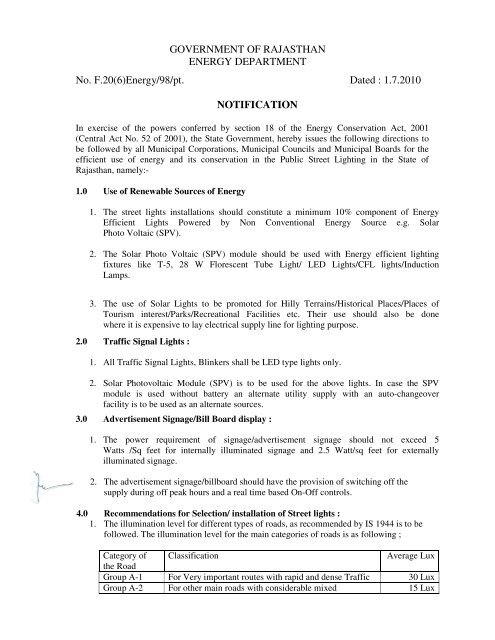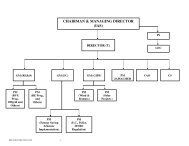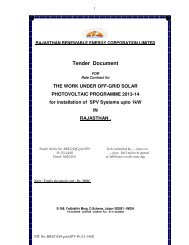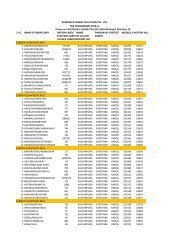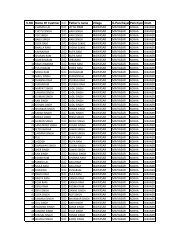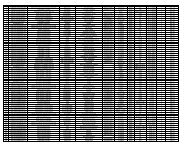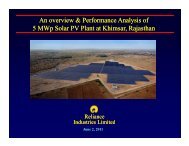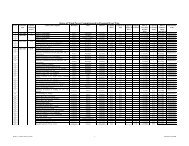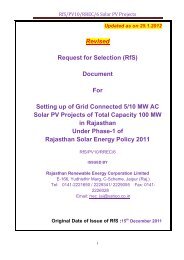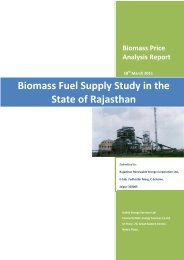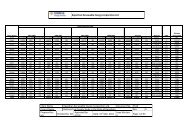Notification for Public Street Lighting Systems - Rajasthan ...
Notification for Public Street Lighting Systems - Rajasthan ...
Notification for Public Street Lighting Systems - Rajasthan ...
Create successful ePaper yourself
Turn your PDF publications into a flip-book with our unique Google optimized e-Paper software.
GOVERNMENT OF RAJASTHANENERGY DEPARTMENTNo. F.20(6)Energy/98/pt. Dated : 1.7.2010NOTIFICATIONIn exercise of the powers conferred by section 18 of the Energy Conservation Act, 2001(Central Act No. 52 of 2001), the State Government, hereby issues the following directions tobe followed by all Municipal Corporations, Municipal Councils and Municipal Boards <strong>for</strong> theefficient use of energy and its conservation in the <strong>Public</strong> <strong>Street</strong> <strong>Lighting</strong> in the State of<strong>Rajasthan</strong>, namely:-1.0 Use of Renewable Sources of Energy1. The street lights installations should constitute a minimum 10% component of EnergyEfficient Lights Powered by Non Conventional Energy Source e.g. SolarPhoto Voltaic (SPV).2. The Solar Photo Voltaic (SPV) module should be used with Energy efficient lightingfixtures like T-5, 28 W Florescent Tube Light/ LED Lights/CFL lights/InductionLamps.3. The use of Solar Lights to be promoted <strong>for</strong> Hilly Terrains/Historical Places/Places ofTourism interest/Parks/Recreational Facilities etc. Their use should also be donewhere it is expensive to lay electrical supply line <strong>for</strong> lighting purpose.2.0 Traffic Signal Lights :1. All Traffic Signal Lights, Blinkers shall be LED type lights only.2. Solar Photovoltaic Module (SPV) is to be used <strong>for</strong> the above lights. In case the SPVmodule is used without battery an alternate utility supply with an auto-changeoverfacility is to be used as an alternate sources.3.0 Advertisement Signage/Bill Board display :1. The power requirement of signage/advertisement signage should not exceed 5Watts /Sq feet <strong>for</strong> internally illuminated signage and 2.5 Watt/sq feet <strong>for</strong> externallyilluminated signage.2. The advertisement signage/billboard should have the provision of switching off thesupply during off peak hours and a real time based On-Off controls.4.0 Recommendations <strong>for</strong> Selection/ installation of <strong>Street</strong> lights :1. The illumination level <strong>for</strong> different types of roads, as recommended by IS 1944 is to befollowed. The illumination level <strong>for</strong> the main categories of roads is as following ;Category of ClassificationAverage Luxthe RoadGroup A-1 For Very important routes with rapid and dense Traffic 30 LuxGroup A-2 For other main roads with considerable mixed 15 Lux
traffic like main city streets, arterial roads andthoroughfaresGroup B-1 For secondary roads with considerable traffic Principal 08 Luxlocal traffic routes, shopping streetsetcGroup B-2 For Secondary roads with light traffic 04 Lux2. The selection of lighting fixtures to be done as follows <strong>for</strong> all the new installations :-SN Width of Road Type of Light1 Up to 30 feet road T-5, Florescent Tube Light 28 W/ LED light14 W/CFL lights ( 2 x 11 W)/ InductionLamps 14 W2 In colonies T-5, Florescent Tube Light 28 W/ LED light14 W/CFL lights ( 2 x 11 W)/ InductionLamp 14 W3 60 feet Main Road Sodium Light 150 W/LED light 100 W /Induction lamps 100W4 Main road greater than 60 feet Sodium Light 205W/LED Light 125/ 150W/Induction lamps 125 W5 Divider Single Arm Pole/HighwayRoad /Main road/VIP RoadSodium Light 205W/LED Light 125/ 150W/Induction lamps 125 W3. The Pole spacing/Height of Pole <strong>for</strong> Group A-1 are as follows and <strong>for</strong> the othercategories the IS 1944 may be referred :-Width ofRoadDistance betweenPolesHeight of Poleabove groundlevelLength ofArmTilt AngleRoad with divider2 X 10 M 36 M 10 M 1.5 M 5 degree2 X 09 M 40 M 10 M 1.5 M 5 degreeRoad without divider15 M 25 M 10 M 1.5 M 15 degree4. The installation of the New <strong>Street</strong> lights should be design based. High efficiencyfixtures only have to be considered <strong>for</strong> this purpose which can result in more polespacing, better illumination and less consumption of energy.5. Incandescent bulbs (GLS) should not be used. Wherever these are installed the samehave to be replaced with 11 W CFL of high power factor and low harmonics/Induction Lamps.6. Within the colonies, at the junctions of the roads Sodium light of 150 W/ 2X28W T-5Florescent Tube lights/ LED Light 72W/ induction lamps 70 W only to be used. Theuse of Sodium Light within the colony is to be restricted and is to be used only wherethe width of both the roads meeting at the junction is more than 50 feet.7. The High mast lights should be used only where highways or bye-passes cross or boththe cross roads are 100 feet wide. The provision of street lights should be restrictedwithin the effective illumination periphery of the High Mast Lights.
8. Preferably the 250 W lamps (HPSV/MH/ used on high mast lights to be replaced with120/150 W Flood Light luminaries of LED lamps depending upon the application andlocation specific illumination requirements.9. Star rated Tube lights only to be used as per Bureau Energy Efficiency (BEE)notification No. 2/11(5)/03-BEE -1 dated 6 th July 2009.10. Appropriate Color Rendering to be selected <strong>for</strong> the lights as per the location requirements.11. The luminaries should be preferably Cut/off type.5.0 <strong>Lighting</strong> Controls and Control Gears :1. The Chokes of the <strong>Lighting</strong> systems <strong>for</strong> all the New installation shall be electronicballast/multi tap ballast with sensor & time controlled switching.2. The luminaries should be preferably Step down type. During the less trafficconditions/off-peak hours the illumination can be reduced by lowering the voltage.This results in energy savings and devices like dimmers/Programmable timers/Energy saving devices should be used <strong>for</strong> this purpose.3. Group lighting control should be preferred rather than individual controls. Theillumination level of the selected group can be reduced effectively with groupcontrolled during off peak hours resulting in energy savings.4. Photo-sensor/SPV based timer switch <strong>for</strong> On-off to be used in all the <strong>Lighting</strong> circuits.5. Switching "OFF" alternate lights during off-peak hours to be ensured by modificationin the electrical connections with switching/timer control.6.0 Data Bank of installed <strong>Lighting</strong> Fixtures :1. Data Bank comprising of the details of Type of lights installed, its Wattage, RoadWidth, spacing of lights, mounting height etc is to be maintained. A uniqueidentification number is to be allotted to every light in the Data Bank.2. Any subsequent change in the Type of installation is to be immediately upgraded in theData Bank.7.0 Replacement and Maintenance of <strong>Street</strong> lights :1. The identification of the inoperative lights should be done only during night Hours. Thelights which are 'ON' during daytime also have to be identified <strong>for</strong> rectification throughregular surveys.2. The replacement of all conventional chokes is to be done with Electronic Chokes/Multitap ballast.3. The replacement of complete florescent Tube light fixture is to be done with EnergyEfficient T-5, Florescent Tube light/LED light/CFL.
8.0 Parks, Recreation centre, pedestrian way etc :1. For the parks, Recreation centers, beautification/landscaping projects, pedestrian way etcenergy efficient CFL/LED/Induction lamps only have to be used.2. Solar Photo voltaic (SPV) based lights should be promoted in the above areas.9.0 Evolving Energy Conservation Projects :1. The energy use should be closely monitored and any excessive consumption should beanalysed <strong>for</strong> corrective action.2. Energy Conservation Project should be evolved and executed by the concernedDepartment of Municipality/council and urban local bodies <strong>for</strong> the reduction in energyconsumption.3. Energy auditing should preferably be carried in whole of municipal area at least once intwo years.10.0 Avoidance of Direct light points :1. The new luminaries should be installed only on metered supply. The metered supply isto be ensured prior to any new installations.2. The existing direct points should be converted into metered road phase supply point onpriority basis.These directions shall come into <strong>for</strong>ce with immediate effect.Copy to the following <strong>for</strong> in<strong>for</strong>mation & necessary action -1. Secretary, Ministry of Power, Govt. of India, Shram Shakti Bhawan, Rafi Marg, NewDelhi.2. Secretary, Ministry of New & Renewable Energy, Govt. of India, CGO Complex, LodiRoad, New Delhi.3. Director General, Bureau of Energy Efficiency, Ministry of Power, Government of India,New Delhi.4. Pr. Secretary, UDH & LSG, Govt. of <strong>Rajasthan</strong> Jaipur.5. Chief Executive Officer, Municipal Corporation, Jaipur/Jodhpur/Kota.6. Commissioner, Jaipur Development Authority, Jaipur.7. CMD, Raj. Renewable Energy Corp. Ltd. Jaipur.8. CMD Jaipur Vidyut Vitran Nigam Ltd. & Chairman, Discoms, Jaipur.9. MD, Ajmer Vidyut Vitran Nigam Ltd. & Jodhpur Vidyut Vitran Nigam Ltd.10. Director, Printing & Stationery, <strong>Rajasthan</strong>, Jaipur with the request to get it published inextraordinary gazette.11. Guard File.


